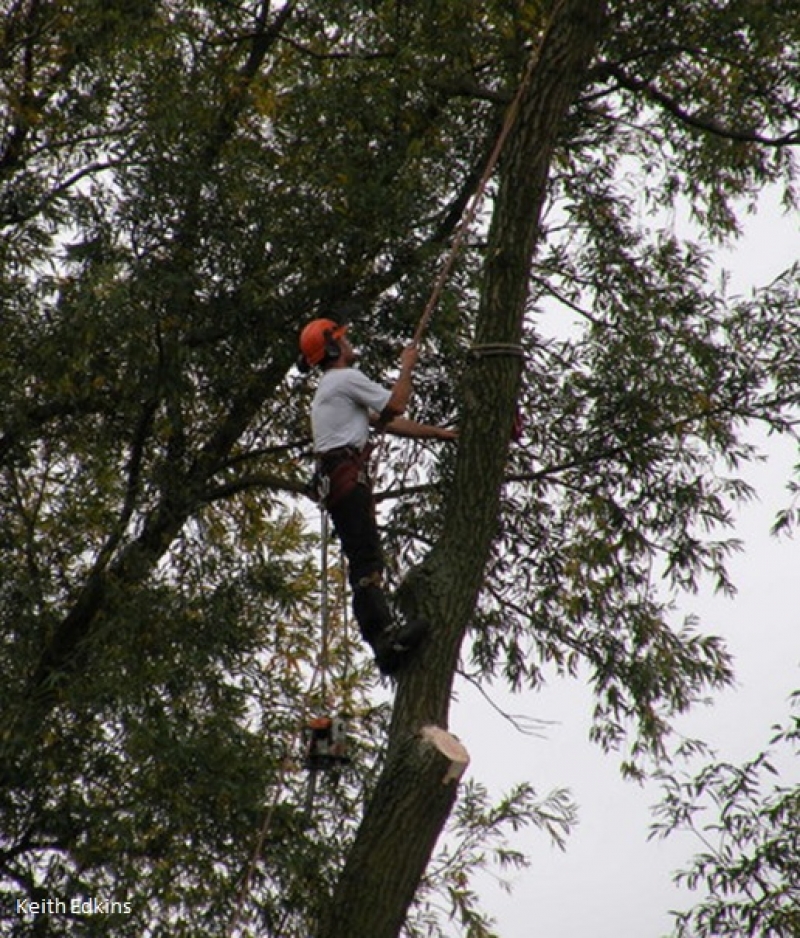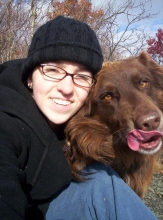
A Day in the Life of an Arborist
Feet spread, body tilted back, two hands on the rope, eyes squinting up through the sun. I can barely see, but I can’t turn away and I can’t drop the rope, even though my arms are burning and I can feel the rope about to slip through my friction-burnt gloves. The growl of the chainsaw revs down, the branch swings free and I slowly begin to lower it. I grab the tips of the branch just as it reaches the ground and backtrack quickly, pulling the limb with me so that the cut end comes to rest at the roots and branch tips are at my feet. I wipe the sweat off my chin with an equally sweaty forearm and walk forward to untie the rope, ready to lower the next branch. 
This is what it’s like to be an arborist. We are tree surgeons. We try to give the trees the best chance at a healthy life while still managing to keep the nearby humans safe and aesthetically pleased. Older trees may need extra support, especially ones that have developed multiple leads, so we install cables to hold branches together at a weak limb joints. Sometimes overhanging branches pose a hazard for homeowners, damage from an ice storm breaks a few limbs or dense foliage obstructs the view to a river. Even while I cut off their arms and fingers, I am an advocate for the trees, working to keep them alive long into the future.
I am the second in command on this crew, admittedly the entire crew consists of only two people, but it’s still an important job. I am the entire of the ground crew. I prune the bushes and small trees, take out the deadwood and suckers and do some miner shaping. There is also a lot of hauling brush involved in my job. Back and forth, back and forth, under a hot sun or through chilly rain, sometimes even over crunching snow. The other member of the crew is the arborist, he (I’m not being sexist here, arborists can be female, but this one happens to be male) does all the major branch removal and climbing. We don’t use bucket lifts, not like you might see on road crews cutting branches to clear the way for an electrical line. Using big trucks or equipment compacts the soil and deprives the tree’s roots from getting oxygen. Instead, we use ropes to climb to uppermost branches.
It’s the climber’s job to do all the major doctoring. He sets the line in a tree with a giant slingshot and climbs up with the help of a saddle, a Blakes hitch knot and some footlocking work. He then pulls out the chainsaw that has been dangling from his saddle and carefully removes the damaged or undesired limbs. As the falling debris makes its way towards the ground I hear a loud, “Heads Up!” That’s just to let anyone nearby know to be careful. Safety is very important for an arborist. We always wear hardhats and I keep the climber’s rope clear of anything it could snag on or get cut by. A few scratches are guaranteed, but other than that the worst that will happen is some sore muscles.
to let anyone nearby know to be careful. Safety is very important for an arborist. We always wear hardhats and I keep the climber’s rope clear of anything it could snag on or get cut by. A few scratches are guaranteed, but other than that the worst that will happen is some sore muscles.
Some branches are so big that they need to be lowered, that’s where I come in. The climber ties a rope (not the one he’s climbing with of course) around a branch and throws it over another branch to act as a pulley of sorts. I take the other end, stand well back and brace myself for an unknown weight of tree to come swinging down. Sometimes the branch will swing out wildly and there will a moment where I think the climber is going to be crushed, but it always rights itself.
It’s not easy, cutting up trees the way we do. I love trees and hate to see them damaged. But I guess that’s why it’s so important to know what’s best for the tree. I know to make an undercut on the bottom of a branch before removing it so that the weight of the branch doesn’t tear off a big strip of bark. You always cut at a perpendicular angle so as to leave the smallest wound possible and when pruning always cut above the branch collar. Trees are resilient and can actually take a lot damage, but if you treat them well, you might not have to call in the tree surgeons very often.
*Heron has worked as the ground crew for an arborist on and off for the past five years.


A bit more of a grueling summer job than the one you have this summer, eh? Very interesting article Heron, I never knew it was so much work being an arborist!